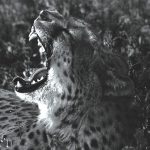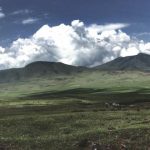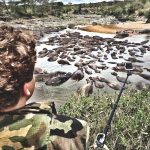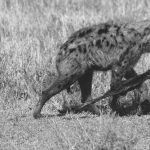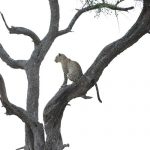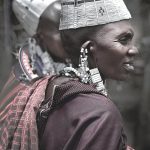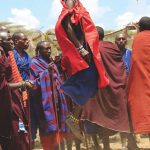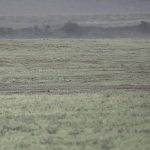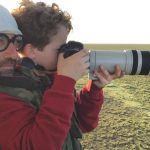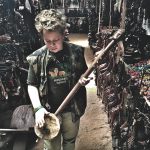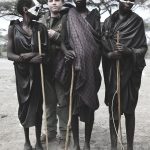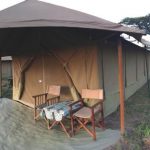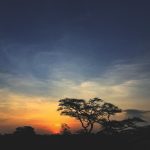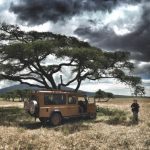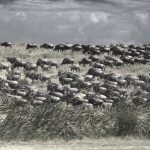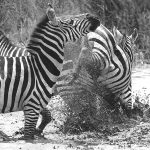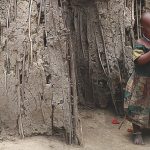By Ramy Shaalan
Photography: Waleed Shaalan
When we first caught up with father and son team, Waleed and Ramy Shaalan, to learn more about their recent excursion to Tanzania, they started off our discussion with one shared sentence. ‘It was the trip of a lifetime’, they said. For renowned local architect, artist and creative Waleed Shaalan, surprising his 12-year-old son Ramy with a life-changing trip to the wilds of Tanzania and the great Serengeti was simply the start of even greater realizations. Little did they know, however, that both of their perspectives would be altered. For Ramy, it was a coming-of-age experience. For Waleed, it was a re-calibration of perspectives. They both learned so much from one another, proving that going back to nature and experiencing Earth in all of its pure glory, is indeed a life-changing experience.
In the span of one week, they embarked on an odyssey-like adventure in Tanzania’s riveting Serengeti National Park, following the migration of more than one million wildebeests that takes these majestic creatures to greener pastures as they follow the moving rainfalls. The migration powerfully illustrates the circle of life, as many wildebeests and other creatures fall prey to more masterful attackers. Both Waleed and Ramy photographed, drew, wrote, and conducted interviews with Tanzania’s indigenous Maasai, enjoying moving conversations about the cycles of life and death that are so evident in nature. Not only did they see the big five – the African lion, elephant, cape buffalo, leopard and rhinoceros, they also managed to sight wild cats, giraffes, hippos, crocodiles, hyenas, gazelles, vultures, warthogs and of course, the iconic wildebeest. Read on to experience Ramy’s African adventure as he chronicled his way through the Serengeti.
Day One: We are Going to Tanzania?!
“These red bananas are amazing!”
Around 15-18 hours earlier at Kuwait Airport, heading for “Oman”:
Dad: “Ramy, get your camera and film this, it is something important.”
Me: “Ugh… Fine…”
(Video Starts)
“Ramy, I have something very important to tell you.”
“What?”
“We have a change of plans.”
“What?” I looked at him with suspicion.
“We’re not going to Oman.”
“I knew it,” I said with confusion.
“Do you know where we are going?”
“Where?”
“We are going to witness one of the most epic events of nature, the migration of 1.5 (million) wildebeest from the Serengeti in Tanzania to Kenya, we are now flying out to Addis Ababa…”
“What?!” I screamed.
“And we are going to Kilimanjaro, here is the ticket, we are going to go to Tanzania.”
I was literally in shock. For the past 3 weeks he said we were going to Oman.
“Are you excited?”
I was in too much shock to answer.
“We are going to Tanzania!” he said.
“What!?”
If only you could see my face!
“Now I know why you lied to the doctor!”
I was in tears. Can you imagine someone telling you that you are going to camp in Oman, but 3 weeks later, after you told all your friends and family, at the airport, (emphasis on the AIRPORT), that you were going on a safari in Tanzania, Africa? Where the great Serengeti Savannah is situated! Where Mt. Kilimanjaro towers high above the land! The Eden of Africa! We are going to Tanzania!
Amazed, tired, excited, and in shock, we head to check in our bags. I left my GoPro in my bag, which we checked in. Bad mistake. I sucked it up and we boarded the plane. We asked for a window seat, and we got one, except without the window. Also, for some reason, the whole plane ride, I kept on hearing random national anthems in my head, and I kept on asking my dad if he was hearing them too, but, it turns out I was hallucinating. Hmmm…
Day Two: What a Drive.
After four hours of sleeping in weird positions, we landed in Addis Ababa Bole Airport and sat down in a small café. I got a small bracelet that says ETHIOPIA and while nothing exciting happened, I still couldn’t believe I was there, and we boarded the plane to Kilimanjaro, Tanzania. This time, we finally got a seat with a window!
Around 12:00 noon, somewhere over Africa:
All I am thinking is, wow, Africa is beautiful.
The puffy white clouds, the Egyptian and Lebanese national anthems ringing in my ears, my dad watching Teenage Mutant Ninja Turtles and the great food… All was good. All was good.
I look outside the window and we are over Tanzania, I can see what looks like a caldera and Mt. Kilimanjaro. It was so breathtakingly beautiful. The metal rooftops of the houses reflected light which made it look like a giant accidently spilled large amounts of glitter over Tanzania while trying to complete his art project. Three words: It was shiny.
Right before we began to land, all I though about was how I was on that plane, looking out, staring at Mt. Kilimanjaro, getting ready to land in Tanzania. If my dad had never tried, and if I never got good grades, we wouldn’t have gone. If my dad didn’t work hard at his job, we wouldn’t have gone. The main factor of success and enjoyment is working, trying and doing your best. I always say, “It’s not that you can’t, it is that you believe you can’t, so believe you can.” The funny thing is that this quote cannot get any truer, and if you don’t believe me, try it out. I am not saying that if you believe you can ace an exam without studying or trying, it will actually happen. Because it won’t. You have to try. It is like trying to bake a cake without actually having anything to cook with. It’s not going to happen.
Now enough of that, let’s cut to the chase.
We arrived at the surprisingly tiny airport in Kilimanjaro. The plane parked a mere 40m from the airport’s entrance. The thing that gave me a bit of the chills were the Ebola warnings and the fact that we had to pass the screenings. We had to fill out our papers and we got our bags and met David, the tour guide. We got in the Land Rover that had two plugs, very comfy seats and a very stubborn window. We headed out to the first lodge in Karatu and on the way we bought some red bananas which brings me back to the first sentence of this article. Those bananas were really good!
We saw some baboons on the street and we drove a long 3-hour drive where we learned a bit about the tribes people there, about the geography of the land and much, much more. We arrived to the first hotel and I jumped in the pool and then we went to bed. I couldn’t sleep. At all.
Day Three: Dancing With the Maasai
We woke up and we packed our bags and continued onwards. We ate breakfast and David took us to Ngorongoro, where I got some “Tanzanite” stone for 36,000 shillings. Turns out it was the worst possible quality of rough Tanzanite, pretty much worth very little. It’s better than nothing, as this precious gem symbolizes good luck. We head out to view the crater from above and it was the most beautiful thing I have ever laid my eyes on.
We continued our drive to the Serengeti National Park and on the way we went to a Maasai village. The village was called Ellerai. The Maasai people are tribesmen and women who live in Tanzania and some parts of Kenya. In total, there are about 50,000 Maasai people in Tanzania who try as hard as possible to keep to their traditions of the past.
One of these traditions is the boy’s transformation from a child to a man. They paint their face white to let everyone know that they are becoming men. A kid, between the ages of 12-16, will be circumcised and heaved into the wilderness to live for weeks, risking infection, attack and disease. An elected elder must carry out the circumcision, and if it’s done in a hospital, the child and parents will be punished. The little men live in huts called Emanyattas for the next 10 years, warding off lions, herding cattle, and starting their own villages. They are no longer kids. They are men. In the end, they get to have over 20 wives.
They showed us their dance, it was very interesting, and their voices were quite good. The women had their babies with them, wearing detailed and intricate works of jewelry made of beads and string. They all wore something called a Shokat, which is like a blanket with some patterns, just like a Scottish kilt, that they wrap around themselves. After the dance, we walked into the village and they had another dance called “Laleyo” in which they show their jumping skills, and my dad and I also joined them. We walked around and they escorted us into one of their huts for an interview. He told us that the Maasai ate 3 meats – cow, sheep and goat. They take the cow, tie the cow’s neck and wait until a vein is clear, they stab it with their spear and collect the fresh, warm blood and mix it with fresh, unpasteurized milk.
Furthermore, the Maasai women build the huts with twigs, animal dung and mud. There are three rooms, the living room, kids’ room, and parents’ room. The house is very tiny though, it is literally meant for sleeping and cooking. I am taller than the hut itself. The Maasai don’t need a big house because they walk for 60km a day. They are truly brave, they kill lions that attack their cattle with three stabs only using their spears.
We went on to see a little cute kid in a kindergarten learning the alphabet. They sang us a song and we even managed to record some footage of this wonderful experience. There has been an ongoing debate about the idea of the Maasai getting an education. Personally, I can see how both arguments are important. They do need to go to school because in the event of a crisis; financially or otherwise, they might get into some trouble, but some may disagree and say that they don’t need school because they have a perfect lifestyle that they have been following for thousands of years, and why should they break the tradition? What do you think?
We bought some souvenirs and left. We spotted some giraffes, an amazing surprise, and we got some good shots and continued to the Serengeti National Park.
It was a long drive, but we finally arrived. I kept on seeing mirages and it was quite weird at first. We enter the start of the Serengeti and all we see is gazelles. Lots and lots of gazelles. Then we start to see the wildebeest and zebras (9 million of them in total) migrating from Kenya to Tanzania, following the rains. Wow, there were so many of them, you can’t even begin to comprehend how many. You can’t even try to count them. Everywhere you looked, they were there. We spotted some hyenas and ostriches. We spotted the heaviest flying birds in the animal kingdom, the Kory Bustard. It can weigh up to 30 KGS and is also served in feasts on very special occasions.
The view was breathtaking. On the way, we saw a very photogenic giraffe. I was very surprised because it even posed for us! Afterwards, we headed to the hot air balloon office to book for the next day, and after that we drove off into an Acacia forest. Acacia trees are my favorite trees; they truly paint a picture of Africa. We noticed that there was not much wildlife in the forest, except for some water buffalos. We drive past an alkaline lake filled with flamingoes. There is no life in the alkaline lake, so the flamingoes feed on algae called Spirulina. The alkaline lake smelled very bad, and I was informed that it was the algae that caused this rancid smell.
When we reached our camp, based in the Ndutu Conservation Area, I slept this time! My father spoke to me about the difference between fear and danger. He told me to be brave like the Maasai warriors, and understand that I can conquer fear and handle danger. We heard howling hyenas, and this surely inspired fear, but he made me laugh when he mentioned that the not-so-innocent mosquito poses the real threat here. Apparently the female African mosquito has killed more humans than all animals, wars and natural disasters combined. We both opted to put on some more insect repellent spray, we each got into our netted beds and slept a deep, deep sleep.
Day Four: Balloons and Mango Juice.
We woke up at around 5:00 a.m. to go start off our balloon safari. It turns out that they needed more people to balance the balloon, so our awesome guide David got to join us for free! As it turns out, it was David and I’s first ever trip on a hot air balloon, and it was a dream come true for all of us. The surprising thing was that the hot air balloon took off sideways, so we had to get in sideways, which was a fun experience.
The view was unbelievable. Trying to explain the experience is like trying to explain color to a blind person. It is such an amazing feeling, being suspended meters off the ground, flying at 15 knots, wind blowing softly on your face, the sun rising over the Serengeti Plains, while the animals run and survive. It makes you think. Nature is amazing. What a way to wake up. We had a rough landing and the adults had some champagne and I had mango juice.
We left the landing site, located in the middle of the Serengeti, and headed back to the ticketing office and had some good breakfast. Behind us were some buffalos and over the hill were millions of wildebeest and zebras. After the tasty breakfast, we made our way back to Ndutu, and saw a majestic cheetah resting under a bush. Cheetahs are the fastest land animals in the world, and their favorite food is Thompson gazelles. Yum. These would make for some good burgers. After taking beautiful pictures of the cheetah, we head off.
We continued our safari journey that day to check out some kopjes (KOH-PEES). A Kopje is pretty much just a hill in a generally flat area, formed when leftover lava spews out from the ground and forms boulder-like structures, where big cats usually love to live. The first kopje we inspected had two young sleeping lions looking to start a new pride. We were quite lucky because in the beginning of the safari we saw lots of animals, but no lions! All tired out from excitement, we head back to our campsite.
Day Five: You are Too Old To Attack.
We woke up that morning and outside the tent were some zebras grazing, and then we left Ndutu. Only 200 meters away from camp, we saw a pride of lions, which explains the grunting and roaring we kept hearing the night before. We drove off and saw even more lions. Some lazed around, some rested, and it was so shocking to me that this was a natural occurrence. We learned about these majestic creatures’ life habits, their mating rituals, and so much more.
As we continued through the dry Serengeti plains and we saw a dead hyena with its guts everywhere, it obviously suffered from a brutal attack. We also witnessed an entire family of elephants; they were so cute. The reason why we drove through the dry plains is to continue following the migration of the animals. We came by some zebras playfully kicking one another, and this reminded me of my friend who loved Muay Thai. We proceeded to find a herd of elephants, and they were blocking the road. The old male looked quite happy, but then he started to charge at us and we had to back away slowly. Since he was about 55 years old though, he couldn’t have reacted fast enough to actually crush us. It’s sad to say their biggest predators are humans. As my grandfather said, “Ivory looks better on a living elephant than off a dead one.”
We head to the last camp in the middle of the Serengeti, in the Acacia Woodlands, which was filled with Tsetse flies, and their bite stings like a bee. On the way we saw a huge herd of buffalo crossing the road, paused to admire the view, and continued on.
Day Six: Luck of the Tanzanite.
We woke up really early and my dad said, “We may see a lion attack today,” I say, yeah, right!
We head out into the darkness and we found hippos grazing and a pride of lions around dawn time. We stuck with the pride for a little and there were many baby cubs, and then…
BOOM! A baby wildebeest runs through the pride, looking for her/his mother, and without hesitation, the cubs jump up and grab the baby wildebeest, strangle her and kills her. We were amazed. A-M-A-Z-E-D. David was also surprised, because he is a full time safari guide at Savannah Explorers, he worked there for 11 years and he saw one attack in his life… 8 years ago, and it wasn’t even successful. What we saw wasn’t just any lion attack, it was a cub attack! Baby lions learning to hunt! Unfortunately it happened too quickly to film, but we got some photos of this miraculous incident! The circle of life unfolded, right in front of our eyes. One life ended for a baby wildebeest, only to reinforce the strength of the growing cub. In a separate sighting, we saw a flailing lioness, after she suffered a bone-shattering blow from a fleeting zebra. The zebra injured this lioness, and we saw her crawl under a rock. Her breathing slowed, and it was as if she was quietly accepting death. We’re not sure if a team of medics were able to rescue her in time, but I learned that even the mightiest animal could fall. It was amazing!
Around 10-30 minutes later, we spot yet another extremely rare animal, the leopard. It was walking slowly, under the bush, and then it climbed an Acacia tree and it lay there, relaxed, stalking the lions as they ate. The leopard was so close, and even David has never been this close to one in 11 years. Obviously neither my dad nor me have ever been close to a leopard or seen a lion attack live in action. I instantly thought of that Tanzanite that I brought from the market. 36,000 Shilling was worth it, and it brought us a lot of luck.
Lady Luck was surely on our side. As we continued on, we saw a blue velvet monkey; they are called as such because the males have blue testicle sacks. We even spotted an incredible 7-meter crocodile. To say that it was huge, was an understatement.
As both Waleed and Ramy rushed back to the airport to make their flight, the father instantly noticed the end of his son’s childhood and the beginning of a new time. Waleed left Africa with a new-found enthusiasm, and a new goal. Both Waleed and Ramy decided that they would revisit Africa’s Kilimanjaro next time, and that they would start a three-year plan of physical fitness and mental strength. They will do this to celebrate Ramy’s 16th birthday on the top of Africa’s highest summit: Kilimanjaro.
For more information, follow Waleed and Ramy Shaalan on Instagram, @WaleedSha3lan and @Ramyofficial.







